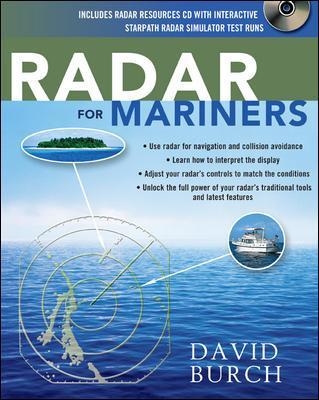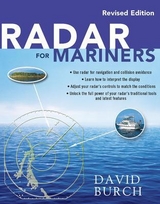
Radar for Mariners
McGraw-Hill Professional
978-0-07-139867-1 (ISBN)
- Titel ist leider vergriffen;
keine Neuauflage - Artikel merken
Become an Expert Small-Craft Radar OperatorNothing beats radar for guiding your boat through the darkest night or the thickest fog. Radar enables you to plot a fix from just a single buoy or landmark, and it is the only navigation tool that tells you not just where you are, but who else or what else is out there with you. Today’s smaller, affordable, more powerful radars make more sense than ever for sailors and powerboaters.This complete, in-depth manual shows you how to:
Choose the best radar model for your sail- or powerboatInstall, adjust, and operate your systemInterpret the images on your radar screenPilot your boat and track the movements of vessels around youUse radar to track and avoid squalls, to outmaneuver competitors in a yacht race, and for other specialized tasksInterface your radar with a digital compass, GPS, or electronic chart
Radar for Mariners comes with a Radar Resources CD-ROM that includes a “field guide” to screen and target images, plotting sheets for printing, an e-book copy of the complete Navigation Rules, sample radar manuals, and more. It also includes a free trial version (30-day period) of the Starpath Radar Trainer simulator, plus an encrypted copy of the Full Radar Trainer you can purchase at a discount nearly equal to the price of this book! (See the enclosed CD-ROM for details.)Praise for David Burch’s Emergency Navigation:"A standout from the otherwise faceless navigation texts that pass through our offices. Anyone venturing offshore should read this book thoroughly."—YachtingPraise for David Burch’s Radar Trainer navigation program:"The Starpath Radar Trainer course is excellent! It is comprehensive and thorough . . . I would not hesitate to recommend it. . . . Any skipper can profit by using this course."—Elbert S. "Mack" Maloney, author of Chapman Piloting & Seamanship
David Burch, the director of the Starpath School of Navigation in Seattle, Washington, has been teaching navigation and seamanship since 1977. He has logged more than 60,000 sea miles, including three wins in the trans-Pacific Victoria to Maui yacht race. He is the author of nine books on marine navigation, including Emergency Navigation (International Marine, 1984), and his magazine articles have appeared in Cruising World, Ocean Navigator, Sailing, and Sea Kayaker. He holds a U.S. Coast Guard Master's license (100 tons). He is also a past Fulbright Scholar and holds a PhD in physics. HOMETOWN: Seattle, WA
PrefaceAcknowledgmentsPart One. Working Knowledge of RadarChapter 1. How Radar WorksRanges, Bearings, and BuoysHead-Up Display ModeMarking and Reading the Screen by HandChapter 2. Operation and “Tuning”Warm-UpStandby ModePicture-Quality ControlsMeasurement ControlsOther Controls and FeaturesSummary and General Adjustment TipsChapter 3. Interpreting the Radar ScreenHow Far Does the Radar See?Three Views of the WorldChapter 4. Radar for Position NavigationRadar versus GPSRadar and GPS: Using Radar UnderwayChapter 5. Radar PilotingMaintaining a Channel PositionRounding a Corner at Fixed Distance OffUsing the Heading Line to Identify Landmarks AheadIdentifying an Entrance ChannelDetecting Current SetOffset TrackingAnchoring with RadarChapter 6. Radar for Collision AvoidanceWorking with Moving TargetsRelative MotionEvaluating Risk of CollisionNorth-Up versus Head-Up in Traffic ObservationsPart Two. Beyond the BasicsChapter 7. Installation, Specifications, and PerformanceInstallationSpecificationsPerformanceChapter 8. Special Controls and FeaturesSpecial ControlsFeaturesChapter 9. False Echoes and InterferenceSide-Lobe InterferenceRadar-to-Radar InterferenceGhost Targets from ReflectionsAbnormal Radar RangesRain and SquallsBridgesChapter 10. Advanced Navigation and PilotingCalibrationsFix from Multiple RangesRange and Visual BearingsOptimizing Radar FixesParallel IndexingMaking LandfallChapter 11. Radar ManeuveringTarget Vessel AspectRelative Motion DiagramE-Chart Programs for Vector SolutionsRules of ThumbSquall TacticsSailboat Racing with RadarCourse to Steer for Desired CPAChapter 12. Radar and the Navigation RulesRule 2. ResponsibilityRule 5. Look-OutRule 6. Safe SpeedRule 7. Risk of CollisionRule 8. Action to Avoid CollisionRule 19. Conduct of Vessels in Restricted VisibilityThe Cockcroft-Lameijer DiagramChapter 13. Looking AheadPC RadarAutomated Identification System (AIS)TrendsPerformance MonitoringAppendixGlossaryList of AbbreviationsReferencesIndex
| Erscheint lt. Verlag | 16.12.2004 |
|---|---|
| Zusatzinfo | 150 Illustrations |
| Sprache | englisch |
| Maße | 185 x 234 mm |
| Gewicht | 446 g |
| Themenwelt | Technik ► Fahrzeugbau / Schiffbau |
| ISBN-10 | 0-07-139867-8 / 0071398678 |
| ISBN-13 | 978-0-07-139867-1 / 9780071398671 |
| Zustand | Neuware |
| Haben Sie eine Frage zum Produkt? |
aus dem Bereich

